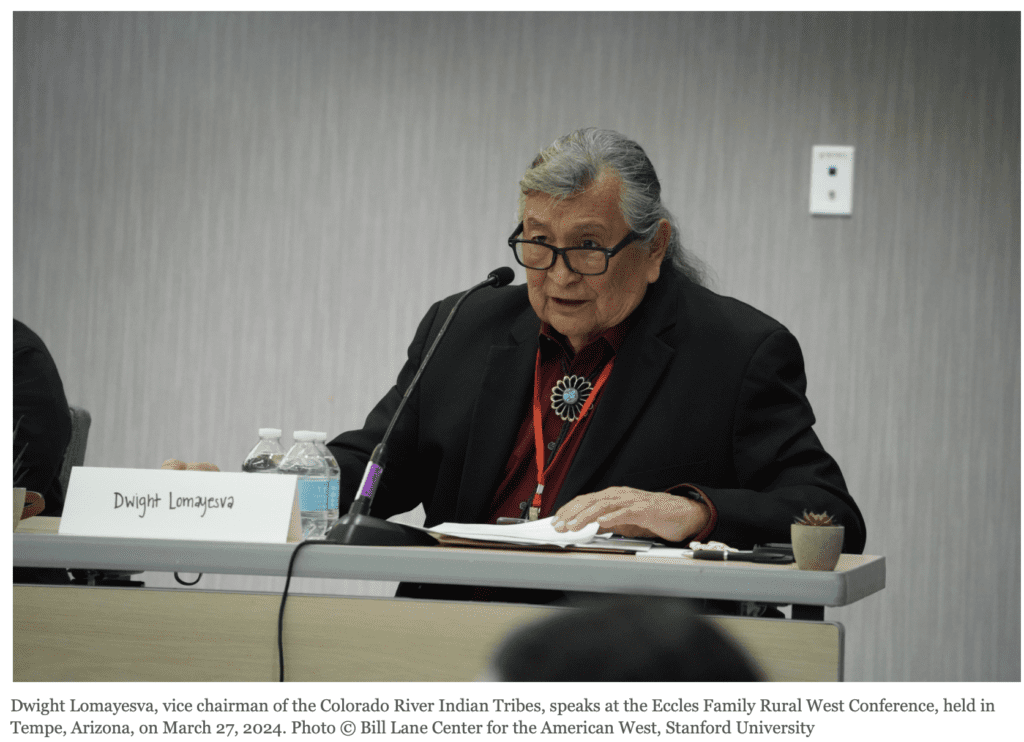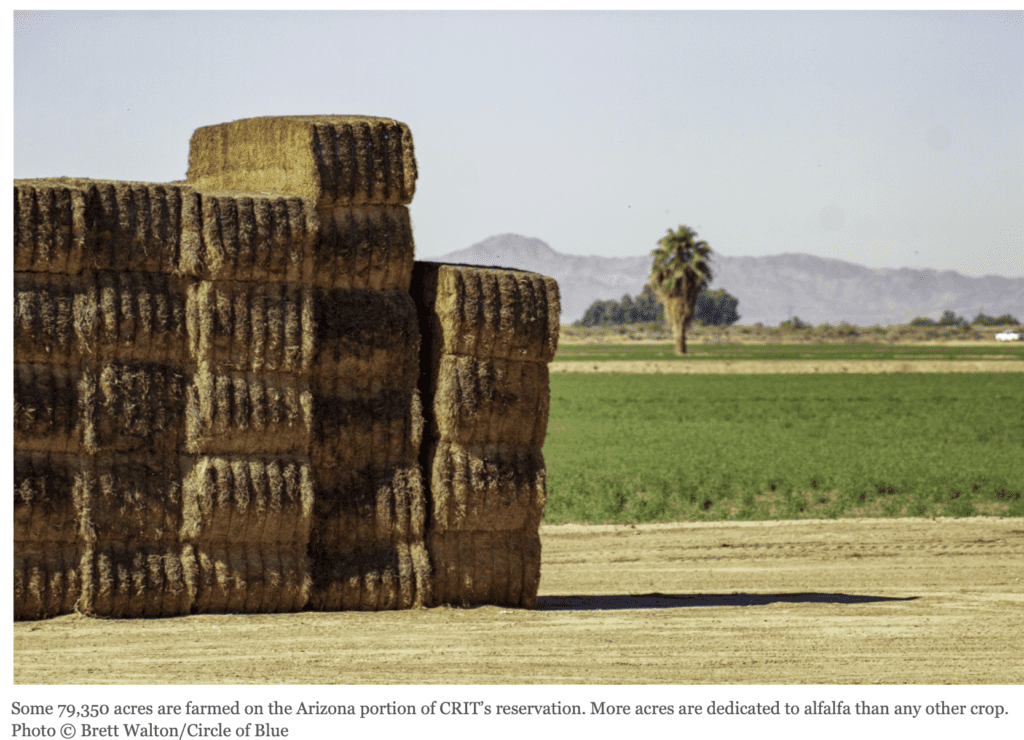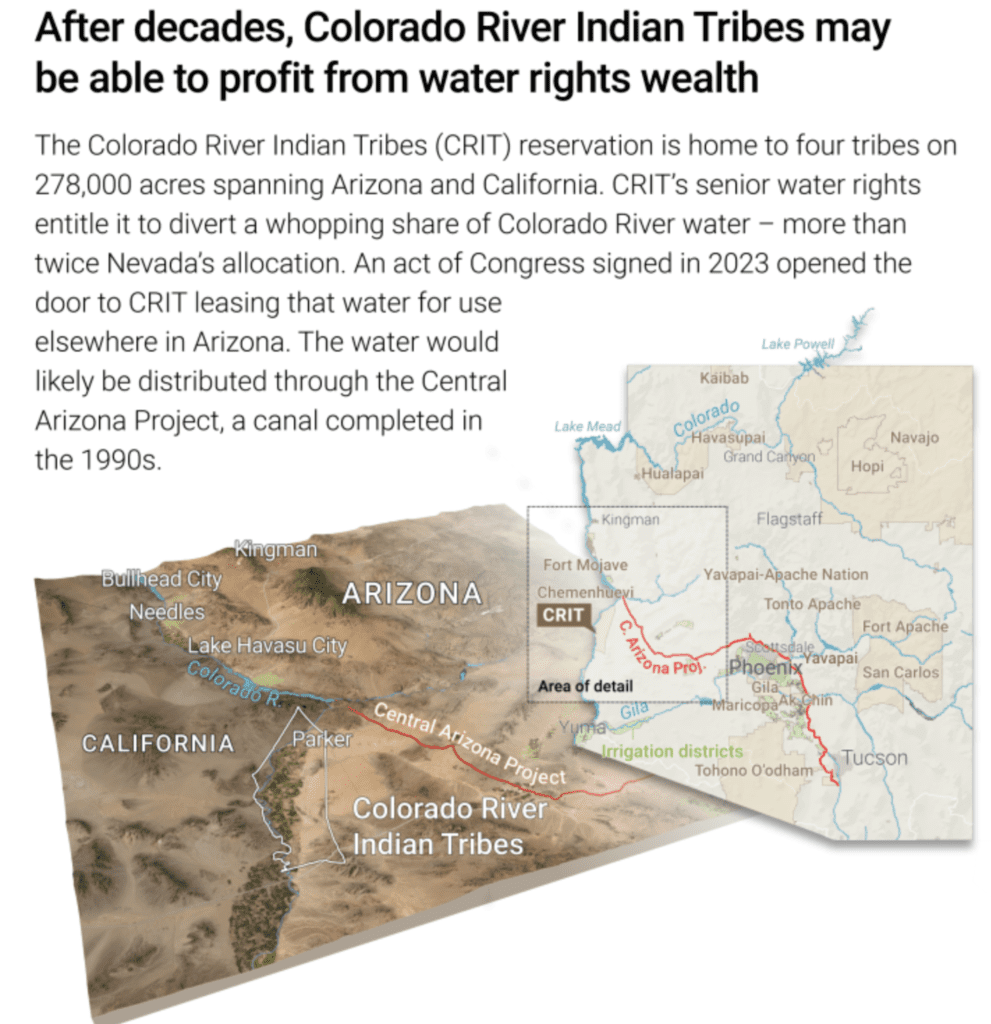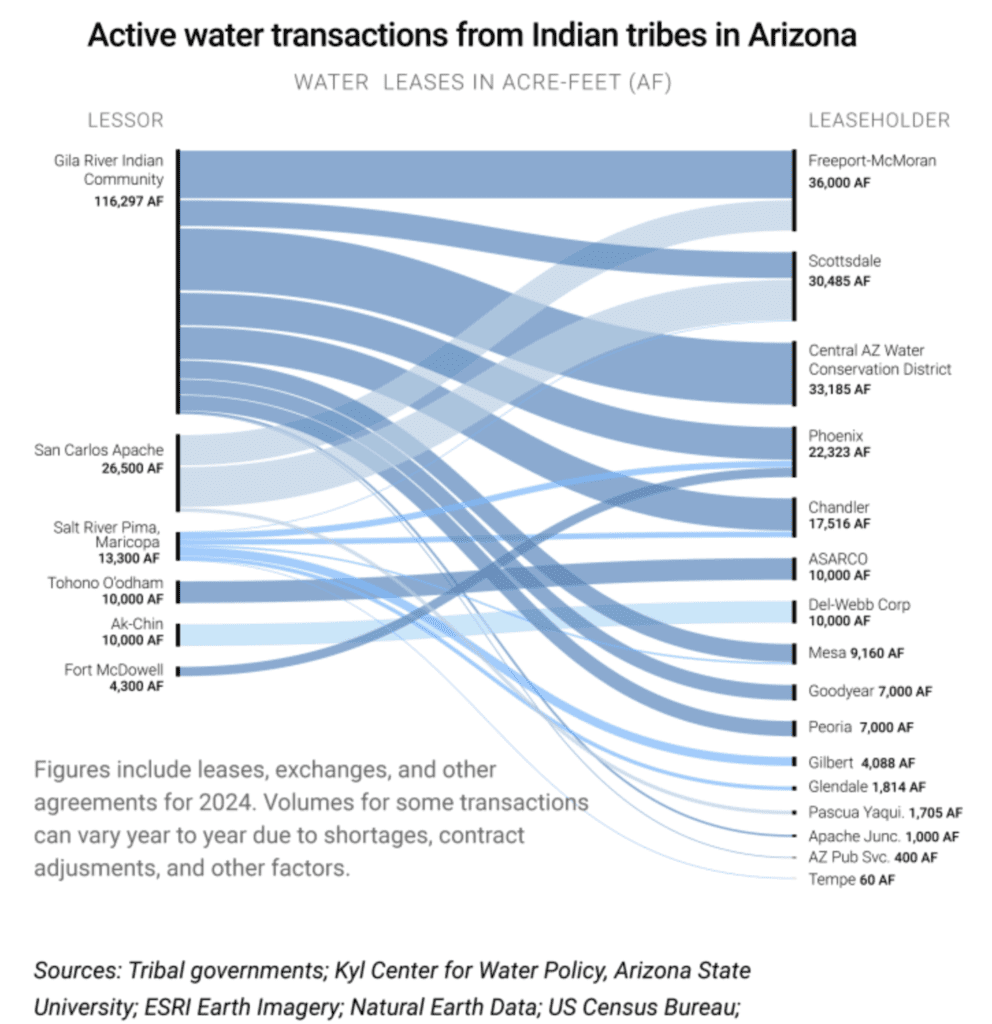Daniel Salzler No. 1268
EnviroInsight.org Four Items August 23, 2024
—————Feel Free To Pass This Along To Others——————
If your watershed is doing something you would like others to know about, or you know
of something others can benefit from, let me know and I will place it in this Information .
If you want to be removed from the distribution list, please let me know.
Please note that all meetings listed are open.
Enhance your viewing by downloading the pdf file to view photos, etc.
The attached is all about improving life in the watershed through knowledge.
If you want to be removed from the distribution list,
please let me know. Please note that all meetings listed are open.
Check our website at EnviroInsight.org
1. Some Of Arizona’s Most Valuable Water Could Soon Hit The Market. A small tribal community along the Colorado River could become a major player in the state’s water supply.

The Colorado River has nourished these lands in present-day western Arizona for millennia, from the ancestral Mohave people who cultivated corn, squash, beans, and melons, to the contemporary farmers of the Colorado River Indian Tribes, or CRIT, whose reservation extends for 56 miles along its namesake river.
CRIT has rights to divert a large volume of Colorado River water – nearly 720,000 acre-feet in Arizona and California combined, which is more than twice Nevada’s allocation from the river. To this point, the water has remained within the bounds of the CRIT reservation. But soon, the water might flow to lands far beyond CRIT’s borders.
Due to an act of Congress signed into law in January 2023, CRIT now has the authority to lease or exchange its water for use elsewhere in Arizona. (The authority does not apply to water rights held by CRIT on the California portion of its reservation.) Agreements signed in April with the Arizona Department of Water Resources and the federal Bureau of Reclamation to fulfill administrative requirements in the legislation brought the tribes another step closer to greater control over their water.
What remains is the work of negotiation, both within CRIT and with potential leaseholders. CRIT leadership must decide what it wants in leasing deals. Leasing this water would represent a financial windfall for CRIT’s more than 4,600 enrolled members. CRIT leadership has framed it as an economic and civic development opportunity.
“With the climate crisis and the drought going on at the present time, there’s going to be a major shortage of water,” Dwight Lomayesva, CRIT Tribal Council vice chairman, said at a conference in March. “But we would like to be part of the solution to the problem.”
A Valuable Asset
CRIT is a union of sorts. Four tribes with distinct histories live on the 278,000-acre reservation that spans Arizona and California. The Mohave, known for farming and beadwork, and the Chemehuevi, masterful basket weavers, were original inhabitants of the land. The Hopi and Navajo came later. The federal Bureau of Indian Affairs relocated members of the two northeastern Arizona tribes to the area after World War Two.
CRIT’s reservation along the banks of the Colorado was established in 1865, making it one of the first in time in Arizona for water rights – and one of the last to lose access to water. Crucially, leased water retains its place in the priority system.
Not only does CRIT have secure water. The tribes also have a lot of it. Comparatively speaking, their water rights are massive. A display at the CRIT Museum makes the point visually. Tubes of foam insulation painted blue depict the volume of water held by tribes along the lower Colorado River. CRIT has the right to divert 662,402 acre-feet per year to its Arizona lands and 56,846 acre-feet to its much smaller landholdings across the river in California. The museum display reflects this bounty – the blue foam bar representing CRIT’s water towers over the others

Lomayesva reiterated the cultural and spiritual significance of the Colorado River to his people. “We want to save the river,” he said. “We’re not just a benevolent nation trying to help other countries and tribes and water districts.”
CRIT’s capacity to lease water is directly related to the farming operations that take place on the reservation. About 79,350 acres are farmed on its Arizona lands, mostly for alfalfa. Some of the land is farmed by a tribal enterprise, but many of the acres are leased by non-tribal members. A majority of the fields are flood irrigated, an inefficient method in which only half of the water is taken up by the crop. The rest eventually flows back to the river or evaporates.
A huge impediment is CRIT’s obsolete means of moving water to its fields. The Bureau of Indian Affairs, a federal agency, owns and operates the Colorado River Irrigation Project, an irrigation system that is, by all accounts, deteriorating and badly needs repair. It was developed piecemeal starting in the 1870s and diverts water into the main line canal at Headrock Gate Dam. Two-thirds of the 232 miles of lateral canal are made of packed dirt.
Lomayesva said that because the tribes do not own the water delivery infrastructure, they would hesitate to invest in it. But he said that leasing deals could provide the capital for farming on the reservation to become more efficient.
CRIT has a history of working with state and federal agencies to protect the Colorado River. The tribes participated in a pilot farmland fallowing program from 2016 to2019, in which they saved 45,373 acre-feet for storage in Lake Mead. That deal was the precursor to a larger commitment in 2020, when the tribes pledged to fallow 10,000 acres of farmland and store 50,000 acre-feet of water per year in the basin’s largest reservoir. For the three-year effort, the tribe earned $38 million, from the state and the Environmental Defense Fund.

“We’re going to only market the water if we can use those funds to develop conservation systems – sprinklers instead of flood [irrigation], pipes instead of dirt ditches, recycle some of that water and reuse it again,” Lomayesva said. “That’s the only reason why we would market our water.”
CRIT recently asked BIA to increase the amount it charges for irrigation water because the tribes believe that the system is underfunded and additional revenue could improve the irrigation infrastructure.
Tribal members voted on an ordinance in 2019 that endorsed leasing and set certain boundaries for its implementation. The ordinance, which passed with 63 percent of the vote, was the result of an attempt a year earlier to recall all nine council members over some residents’ objections to leasing.
Under the ordinance, Tribal Council intends that the same number of acres will be farmed after water is leased. “We are farmers,” Lomayesva said. “We are farmers first, and we will probably always be farmers. And we want to continue farming. But the savings from conservation efforts, we could make some of that water available.”
The way for that to happen is for farming on the reservation to become more efficient – and that means applying less water to the fields. It could happen through conservation. But what tribal leaders like Lomayesva really want is a better irrigation system.
“Water could be made available for conservation or off-reservation leasing, exchange or storage in accordance with the requirements of the federal legislation and agreements if deferred maintenance was addressed along with improvements to the irrigation project,” according to a statement from the tribal government.
Many leases signed as part of a settlement extend for 99 or 100 years. CRIT’s authorizing legislation caps leases or exchange agreements at 100 years. But otherwise CRIT will be a free agent, able to negotiate its terms. Several water policy experts in Arizona interviewed for this story said they heard CRIT was considering a lease length of 25 years. The tribes, however, said in a statement that they have not decided any lease parameters.


2. Are You A Starbucks Coffee Drinker? Then You Should Know The Answer To These Two Questions. a. How many Starbucks stores are there? b. How many coffee combinations does Starbucks offer?
a. i. 390 b. i. 17
ii. 3,900 ii. 170
iii 39,000. iii. 1,700
iv. 3.9 million iv. 170,000
Source: Wall Street Journal Aug 16, 2024
3. It’s About Time: Thousands of Disaster Survivors Urge the Department of Justice to Investigate Fossil Fuel Companies for Climate Crimes. More than 1,000 self-identified survivors of climate disasters and about 10,000 total signers of a letter calling on the U.S. Department of Justice to investigate fossil fuel companies for climate-related crimes.
It’s the latest in a growing trend of legal action attempting to hold the fossil fuel industry accountable for the human costs of climate change, and a newer push to put companies and industry executives in criminal court.
“The folks who are injured or lose their homes or [are] killed in [climate-driven disasters], those aren’t just tragic accidents,” said Aaron Regunberg, a senior policy counsel at Public Citizen. “They’re the result of specific reckless or knowing conduct by particular corporate actors that generated a substantial portion of all the greenhouse gas emissions that caused climate change and that engaged in this massive campaign of deception and delay, specifically in order to stop the actions that would have alleviated or avoided those disasters.” Read the entire story at: https://insideclimatenews.org/news/16082024/justice-department-protest-to-investigate-fossil-fuel-companies-climate-crimes/
4. OSHA 8 Hr Refresher Class. Need your OSHA 8 hour refresher? There will be a class in September that will offer a breakfast and lunch. Cost $80.00 A specific date will bee disclosed shortly. Questions or to register, contact Dan at [email protected] or call me at 623-203-7178
Answer to No. 2 a. ii 3,900, b iv. 170,000
Copyright: 2024 EnviroInsight.org
